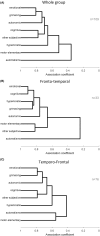Ictal semiology in temporo-frontal epilepsy: A systematic review and meta-analysis
- PMID: 39724402
- PMCID: PMC12067355
- DOI: 10.1002/epd2.20328
Ictal semiology in temporo-frontal epilepsy: A systematic review and meta-analysis
Abstract
We performed a systematic review of the ictal semiology of temporo-frontal seizures with the aim to summarize the state-of-the-art anatomo-clinical correlations in the field, and help guide the interpretation of ictal semiology within the framework of presurgical evaluation. We conducted the systematic review and meta-analysis, and reported its results according to the Preferred Reporting Items for Systematic Review and Meta-Analysis statement. We searched electronic databases (Scopus, PUBMED, Web of Science, and EMBASE) using relevant keywords related to temporal, frontal and sublobar structures, semiology, and electroencephalography/stereoelectroencephalography exploration. The risk of bias was evaluated using the QUADAS2. We included articles in English, reporting the seizure semiology of patients with temporal lobe epilepsy with temporal-frontal involvement and patients with frontal lobe epilepsy and fronto-temporal network involved. We performed hierarchical cluster analysis to determine signs and symptoms associated with the temporo-frontal epileptogenic network for all patients and for each subgroup (frontal/temporal seizure onset). Fisher exact test was performed to evaluate the difference in seizure freedom and clinical sign/symptom occurrence in patients that underwent unilobar versus bilobar resection. Meta-analysis on the prevalence of temporo-frontal/fronto-temporal involvement applying a random-effect model was used. We included 40 articles and we extracted data from 109 patients. The meta-analysis showed the total prevalence of temporo-frontal/fronto-temporal network involvement was 19.75%, CI 12.02-27.47, high heterogeneity (82.71%). For the whole group and subgroups, the main cluster of clinical manifestations is emotional, autonomic, cognitive, grimace, hyperkinetic (association coefficient higher than .6). Elementary motor semiology is significantly associated with multilobar resection (p = .022 whole group and p = .0012 fronto-temporal subgroup). Fifty-eight patients were seizure-free after surgery. There was no significant difference between seizure freedom in uni versus bilobar resections (p = .28). Seizures involving temporo-frontal/fronto-temporal network usually manifest with a cluster of signs and symptoms: emotional, autonomic, grimace, cognitive and hyperkinetic behavior. Based on semiology, one cannot distinguish between fronto-temporal and temporo-frontal cases at individual patient level. In those patients undergoing a surgical procedure, elementary motor seizure semiology is significantly associated with multilobar resection.
Keywords: SEEG; anatomo‐clinical correlation; epilepsy surgery; ictal semiology; systematic review; temporo‐frontal epilepsy.
© 2024 The Author(s). Epileptic Disorders published by Wiley Periodicals LLC on behalf of International League Against Epilepsy.
Conflict of interest statement
Authors have no conflict of interest to declare.
Figures





Similar articles
-
Semiology of hyperkinetic seizures of frontal versus temporal lobe origin.Epileptic Disord. 2019 Apr 1;21(2):154-165. doi: 10.1684/epd.2019.1047. Epileptic Disord. 2019. PMID: 31010798
-
Ictal kissing in a patient with right frontal lobe epilepsy.Epileptic Disord. 2019 Oct 1;21(5):453-457. doi: 10.1684/epd.2019.1097. Epileptic Disord. 2019. PMID: 31708491
-
An analysis of clinical seizure patterns and their localizing value in frontal and temporal lobe epilepsies.Brain. 1996 Feb;119 ( Pt 1):17-40. doi: 10.1093/brain/119.1.17. Brain. 1996. PMID: 8624679
-
Semiology of seizures with temporo-polar or "medio-lateral" temporal origin: A systematic review.Epileptic Disord. 2025 Apr;27(2):187-195. doi: 10.1002/epd2.20329. Epub 2025 Mar 12. Epileptic Disord. 2025. PMID: 40072874 Free PMC article.
-
The localizing value of mimic ictal semiology: A systematic review of the spectrum.Epileptic Disord. 2025 Jun;27(3):358-373. doi: 10.1002/epd2.70004. Epub 2025 Mar 4. Epileptic Disord. 2025. PMID: 40035641
References
-
- Blumenfeld H, Rivera M, McNally KA, Davis K, Spencer DD, Spencer SS. Ictal neocortical slowing in temporal lobe epilepsy. Neurology. 2004;63(6):1015–1021. 10.1212/01.WNL.0000141086.91077.CD/SUPPL_FILE/E3.DOC - DOI - PubMed
Publication types
MeSH terms
LinkOut - more resources
Full Text Sources
Medical

